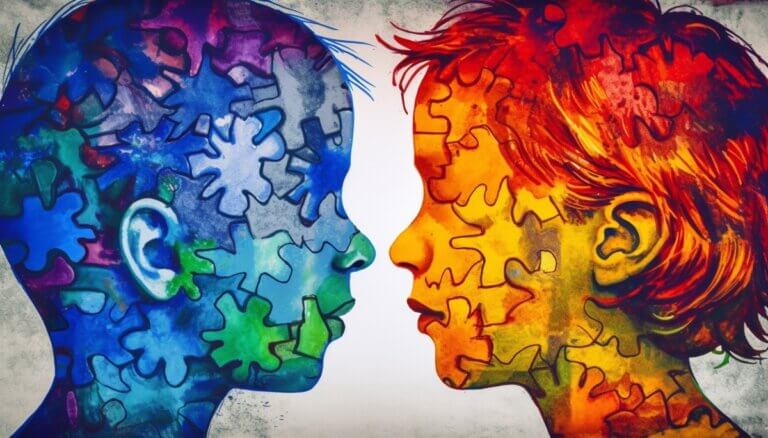Table of Contents
Emotional Intelligence in Team Context

Self-awareness and Empathy
Emotional intelligence and creativity form the foundation for an innovative environment where individuals and teams can fully realize their potential. Self-awareness is a key component as it allows us to recognize and understand our own emotional states. This is essential for team innovation, as high self-knowledge is associated with better performance, more effective communication, and constructive conflict management.
The Role of Self-Awareness in a Team Context
Imagine a project team working on a complex task. In the midst of it is Alex, who recognizes his stress level early thanks to good self-awareness. He uses stress management techniques before his work performance suffers or he triggers conflicts within the team. This ability has a positive impact on the team atmosphere, as potential sources of conflict are minimized and instead, space for creative thinking is created.
Another example is Jana, who understands her own creative processes and knows that she works best under time pressure. By strategically using this self-knowledge, she can organize her creativity phases around important deadlines, which benefits the team’s innovation promotion.
Empathy as an Engine of Innovation
Empathy is the counterpart to self-awareness and just as important for team dynamics and innovation. Empathetic employees and leaders sense the emotional needs of their counterparts and can thereby build stronger trust and a deeper connection within the team. This fosters an environment where ideas freely circulate and creative thinking is stimulated.
Consider the example of Niklas, a team leader who practices active listening and thus recognizes the concerns of his team. Through his understanding of the emotions of the team members, he can provide targeted motivation and individual support. Thus, a motivating team atmosphere is created, which is of great importance for team innovation.
As individuals like Alex, Jana, and Niklas develop their emotional abilities, they not only contribute to a positive team climate but also lay the foundation for genuine innovation work. Emotional intelligence and creativity are closely intertwined and create the ideal conditions for individual talents to form a successful, innovative team.
Self-regulation and Social Skills
Emotional Intelligence and Creativity are inseparably linked when it comes to the environment of team innovation and fostering innovation. The ability to understand and regulate one’s own emotions is just as crucial for the individual as it is for the collective. It helps us to cope with stress and is key in conflict resolution.
Effective Self-Regulation in Teams
Imagine a team under pressure to advance a groundbreaking idea. The stress level is high, and the potential for conflict is great. In such moments, effective self-regulation is essential. Teams capable of individually and collectively managing their emotions often achieve a balance that promotes creative thinking. Suppose a team member reacts angrily to a rejected idea. Emotional intelligence allows the individual – and the team – to recognize that this reaction is human but can hinder the innovation process. A self-regulation technique would be to take a short break, breathe deeply, and reflect on the emotions before responding constructively to the feedback.
- Team members who learn to recognize signs of stress in themselves and others early on and respond to them contribute to the relaxation of the entire group.
- Open communication about stress factors and sensations can help the team to manage them together.
- Through common regulatory strategies such as mediation techniques or mindfulness-based exercises, the team can improve its problem-solving ability.
Social Skills as a Driver of Innovation
Emotional intelligence also includes social skills such as empathy, cooperation, and effective communication. These skills are essential for promoting team innovation. In a discussion, a team member with high emotional intelligence might realize that a colleague with a differing opinion wants to be understood, not attacked. A practical example: A software development team is working on a complex problem, and a member suggests an innovative, yet unorthodox solution. Instead of immediately presenting counterarguments, the team members use their social skills to practice cooperative problem-solving. They ask questions, listen, and build upon the new ideas instead of questioning them. This approach can lead to an atmosphere in which radical innovations can emerge.
- Teams that learn to communicate effectively and actively listen manage to reduce misunderstandings and improve collaboration.
- Empathy allows team members to put themselves in others’ shoes, which builds trust and ultimately boosts willingness to innovate.
- The ability to express and accept criticism constructively strengthens mutual appreciation and promotes a culture of open innovation.
Innovation management thus requires not only technical expertise and creative skills but primarily a solid foundation in emotional intelligence. Teams that learn to develop and apply these skills are the true winners in the constant race for innovation.
Emotional Intelligence as a Catalyst for Creativity

Motivation and Inspiration
The Power of Intrinsic Motivation
Innovation management, emotional intelligence, and creativity are the core of successful teams. Leaders who understand and embody these elements can create an atmosphere where employees feel understood and appreciated, and are empowered to develop and implement their own ideas.
Emotional Intelligence plays a crucial role in igniting the inner fire of intrinsic motivation – that invisible but powerful element that drives people to constantly improve themselves and their actions. It involves recognizing and supporting individual passions so they can serve team innovation.
- Consider, for example, a team leader in software development who promotes the personal development goals of his employees. This not only leads to higher job satisfaction but also to more innovative and creative solutions in projects.
- Another example is a department head in an advertising agency who conducts regular brainstorming sessions where all ideas are treated equally. This practice reveals the creative potential of each team member and results in successful campaigns.
- Or consider a leadership figure in the healthcare sector who uses Emotional Intelligence to foster a culture of openness through genuine empathy and sincere feedback. This enables staff to actively engage in innovation processes and improve patient care.
Inspiration as an Innovation Driver
Inspiring employees is an art that goes beyond mere motivation. It creates an environment where the phrase “Creative Thinking” becomes a mantra. An emotionally intelligent approach can thus enhance the competencies of each individual leading to synergistic team innovation.
Studies show that employees who feel inspired are more likely to think outside the box and develop true innovations. This sense of inspiration can come from a supervisor who is enthusiastic themselves and translates this enthusiasm into inspiring visions that the team aims to achieve together.
A practical example is a technology startup whose founder shares her enthusiasm for sustainable energy, thereby sparking innovative ideas for environmentally friendly products. Another example is seen in educational institutions, where teachers through emotional intelligence foster a culture of critical thinking that motivates young people to push boundaries and create new things.
Emotional Intelligence is not just a tool for personal success. It is a transformative force that sparks the flames of creativity within a team and turns these into the blazing fire of innovation. Integrating Emotional Intelligence into everyday work not only creates a motivating environment but also inspires people to achieve peak performances that together make the impossible possible.
Conflict Resolution and Innovation
Emotional intelligence and creativity are two key competencies that have gained significant importance in today’s workplace. Particularly in the field of innovation management, they play a crucial role in constructively resolving conflicts and driving team innovation.
The Role of Emotional Intelligence in Conflict Resolution
The ability to recognize emotions in oneself and others and respond appropriately is a core component of emotional intelligence. In a team context, a high level of emotional intelligence promotes an atmosphere of trust and openness. Emotional intelligence allows tensions to be identified early on and counteracted before they escalate. In this way, disagreements are not only quickly resolved but also creatively utilized.
- A team leader with high emotional intelligence will notice when a team member is frustrated and can initiate a conversation to clarify the causes.
- Through active listening and empathy, opposing views can lead to a new, joint solution.
- Understanding others’ perspectives creates a productive atmosphere where creative thinking thrives.
Creativity and Innovation Promotion through Emotional Intelligence
Conflicts are often fertile ground for innovation, as they encourage looking beyond the conventional and questioning established patterns. Emotional intelligence is the key to harnessing creative potential from conflicts.
- In a team-internal conflict about product development, a compassionate manager encourages participants to focus on the common goal and develop creative alternatives.
- The emotionally intelligent handling of criticism creates a culture of openness, where innovative thinking is not suppressed by fear of rejection.
- Emotional intelligence allows different viewpoints to be seen as an opportunity for team innovation, rather than an obstacle.
Real Case Studies and Their Insights
Real examples from the business world show how emotional intelligence and innovation management work together to achieve outstanding results. Companies like Google and Pixar, for example, strongly promote a culture in which openness and mutual understanding are encouraged – with impressive success.
- Project teams at Google, supported by ‘Psychological Safety,’ show a higher willingness to take risks in the creative process, thereby enhancing their rate of innovation.
- At Pixar, great emphasis is placed on open exchange, encouraging employees to freely express creative ideas – a practice reflected in groundbreaking animated films.
- Studies show that companies that integrate emotional intelligence into their conflict management strategies develop innovative solutions faster and more successfully.
In summary, emotional intelligence is an indispensable tool for any modern company that aims for sustainability and growth through innovation. It not only establishes the basis for effective conflict resolution mechanisms but also acts as a catalyst for creative processes and team innovation. By embedding emotional intelligence at the heart of corporate culture, pathways open up for a vibrant, innovative future.
Summary
Emotional intelligence and innovation management form a critical alliance that significantly contributes to the success enhancement of teams. The ability to recognize one’s own and others’ emotions and to use them constructively drives innovation promotion and creativity in project groups significantly forward. Particularly self-awareness and empathy are at the forefront here and play a central role in efficient team innovation.
The Importance of Self-Awareness
A pronounced self-awareness allows individuals, as described in our example, to understand their own emotional state and respond appropriately. This prevents unnecessary conflicts and creates space for creative thinking.
Through individual awareness and the ability to self-regulate, teams promote a healthy working environment and thus enhance their collective performance capacity.
Emotional intelligence and creativity also reinforce each other in the context of innovation management practice. By regulating one’s own emotions and developing an understanding for those of colleagues, a platform is created on which innovations can thrive.
Promotion of Creative Thinking and Team Innovation
Innovation promotion requires not only technical knowledge and creativity but also social skills. Teams that master empathy and effective communication reduce misunderstandings and strengthen the collective innovation potential.
By specifically strengthening emotional intelligence, individuals are not only supported in their personal development but also contribute significantly to the innovative power of the entire team. In a management context, it thus becomes clear that teams with strong emotional connections and an open innovation culture are demonstrably more successful.
Emotional intelligence and creativity also positively influence conflict resolution within a team. A constructive approach to tensions opens up new perspectives for innovation and supports the creative process. Real case studies in leading companies, such as Google and Pixar, illustrate the success of emotionally intelligent leadership and the associated high rate of innovation.
In summary, it is evident that emotional intelligence and innovation management together form the foundation for a forward-looking, creative, and successful working environment. Those who firmly establish these competencies within a company lay the groundwork for sustainable development and outstanding innovations.
FAQ – Emotional Intelligence and Innovation Management
How does emotional intelligence contribute to improving innovation and creative thinking in teams?
Emotional intelligence promotes a deeper understanding and stronger empathy within teams, which helps to create a trusting and open atmosphere where new ideas and creative approaches can thrive. It enables individuals to express and accept criticism constructively, which is essential for the iterative innovation process. Furthermore, emotional intelligence enhances the ability to recognize and integrate the perspectives of others, leading to more diverse and original solutions.
How does emotional intelligence contribute to enhancing teamwork and creating a fertile ground for innovation and creativity?
Emotional intelligence promotes a climate of trust and openness in teams, where each member feels understood and valued, enhancing collaboration and creating space for new ideas. People with high emotional intelligence can constructively resolve conflicts and stimulate the intrinsic motivation of their team members, which in turn creates an environment where creativity and innovation can thrive. A team that acts with emotional intelligence uses empathy and self-regulation to achieve a synergy that places collective success above individual endeavors, thus preparing the ground for shared innovative excellence.
How can emotional intelligence in teams contribute to enhancing innovation and creative thinking?
Emotional intelligence within a team creates an atmosphere of trust and safety, which encourages members to freely express ideas and take risks, essential for innovation. The ability of team members to recognize and regulate emotions in themselves and others enhances collaboration and respectful interaction, in turn, fostering creative thinking as constructive criticism thrives in a supportive environment.




